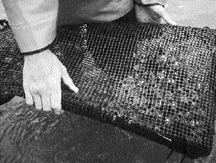
|
Archives:
Spring 2000 Table
of Contents Shellfishing is big business in the Commonwealth. The commercial value of wild shellfish harvested in 1996 was over $21 million. Shellfish grown by aquaculturists added another $4.5 million. As an industry, shellfish aquaculture has seen steady increases over the last decade. According to the Scott Soares, the Commonwealth’s aquaculture coordinator, the number of acres under cultivation and the number of shellfish aquaculturists is increasing at a rate of approximately 10 percent a year. As with agriculture and other industries dependent on hard-to-predict factors such as weather and product demand, aquaculture can be a tricky business. Disease is one variable that can devastate a crop in agriculture and aquaculture, translating to substantial losses for the farmers. A recent workshop co-sponsored by the WHOI Sea Grant Program, the Southeastern Massachusetts Aquaculture Center (SEMAC), the Cape Cod Cooperative Extension Program, and the Massachusetts Aquaculture Association, and hosted by the Cape Cod Museum of Natural History, focused on shellfish disease, particularly as it relates to the aquaculture industry.
Speakers, including pathologists, growers, and industry representatives, delivered a recurring message: shellfish diseases are not only here, they are here to stay. And, most likely, they concur, additional diseases will be discovered in the future. The good news? These diseases are not harmful to human consumers. Roxanna Smolowitz, a pathologist at the Marine Biological Laboratory, studies oyster diseases and QPX, the relatively new quahog parasite that derives its moniker from the term quahog parasite unknown. She says that the potential for organisms to become pathogenic is always there, given the right circumstances. For diseases to occur, says Smolowitz,
"there has to be an interaction of three factors: host susceptibility,
agent virulence, and environmental conditions." Without the right
combination of each of these, the disease can either decrease in
amount or severity or be eliminated. But, Smolowitz was quick to
point out, "[getting a disease] is not that hard." Joining Smolowitz and Hillman and presenting data from several years’ research on shellfish disease in Massachusetts and Delaware Bay was Robert Barber, a pathologist with the Haskins Shellfish Research Laboratory of Rutgers University. Barber has studied MSX (multinucleated sphere unknown), dermo (short for Dermocystidium marinus, the initial classification of the parasite that causes the disease; the parasite was later found to be of the genus Perkinsus), and JOD (juvenile oyster disease) in oysters and QPX in clams. In the U.S., MSX and dermo were first observed in the mid-Atlantic region. These, along with JOD and QPX, are now present in Massachusetts. Although health examinations are done to prevent the spread of disease and to identify populations at risk of significant disease impacts, pathologists concede that the spread of disease is virtually inevitable. When disease is prevalent throughout a region, what explains total devastation in one shellfish grant and not in another–even an adjacent plot? According to Smolowitz, that might be explained, at least in part, by one or a combination of two factors: the direct effect of environmental parameters on the organism or the parasite, or the result of a generalized stress on the host. Nearly as important as understanding shellfish diseases and the ways disease affects an animal (at the individual, population, or species-specific level), is knowing how to manage disease. Not to be mistaken with solutions or cures, management options simply offer growers a way to work around disease. As evidenced by the recent workshop, interaction between scientists, industry, and regulators is essential–not only in the identification of disease and understanding its impacts, but in order to move forward with management options. A panel discussion focusing on the future ended with a call for shellfish disease monitoring programs throughout the Commonwealth. Long-term monitoring programs in the Delaware Bay and Chesapeake Bay regions have proven extremely beneficial. Rick Karney, shellfish biologist and director of Martha’s Vineyard Shellfish Group, says monitoring programs offer "an early warning to growers and managers." If an area tests positive for a disease, says Karney, "growers and managers can plan what to do with their beds. There are economic options they can take that may lessen their losses." Recently, Barnstable County announced that it had funds available to begin a sampling and monitoring program for a number of sites in Massachusetts. While scientists continue to study these diseases in hopes of providing workable solutions for the industry, many growers remain committed to the promise aquaculture holds. Richard Kraus, hatchery owner and operator of Aquacultural Research Corporation in Dennis, seemed to echo the bittersweet plight of growers and scientists in the room when he said, "The number one question people always ask me is, ‘Why are you still in the business?’ Well, I guess it’s because I’m an optimist." |
